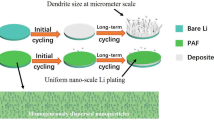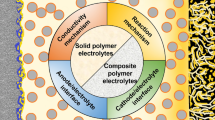Abstract
The volume of the metallic lithium anode in all-solid-state Li metal batteries increases significantly due to the lithium dendrite formation during the battery cycling, and the rough surface of lithium metal also reduces Li-ion transport in Li/electrolyte interface. In this work, we developed a solid polymer composite by adding the low-cost Si3N4 particles to protect the lithium anode in all-solid-state batteries. The Fourier transform infrared spectroscopy (FTIR) data show that the surface of 10 wt % Si3N4 particles interacts with the polyethylene oxide (PEO) and lithium bis(trifluoromethanesulfonyl)imide (LiTFSI) salt; the interaction restricts the anion mobility and improves the ionic conductivity (1 × 10−4 S·cm−1) and lithium-ion transference number (0.28) of the composite electrolyte. The lithium metal anode is well protected by the composite electrolyte in all-solid-state cells, including symmetric and Li/LiFePO4 cells. The lithium dendrite growth suppression by this composite electrolyte indicates the possible application of these low-cost composite electrolytes for lithium metal protection.
Graphic abstract






Similar content being viewed by others
References
Goodenough JB, Kim Y. Challenges for rechargeable Li batteries. Chem Mater. 2010;22(3):587.
Etacheri V, Marom R, Elazari R, Salitra G, Aurbach D. Challenges in the development of advanced Li-ion batteries: a review. Energy Environ Sci. 2011;4(9):3243.
Tarascon JM, Armand M. Issues and challenges facing rechargeable lithium batteries. Nature. 2001;414:359.
Wu M, Liao J, Yu L, Lv R, Li P, Sun W, Tan R, Duan X, Zhang L, Li F, Kim J, Shin KH, Seok Park H, Zhang W, Guo Z, Wang H, Tang Y, Gorgolis G, Galiotis C, Ma J. 2020 roadmap on carbon materials for energy storage and conversion. Chem Asian J. 2020;15(7):995.
Zhao Q, Stalin S, Zhao CZ, Archer LA. Designing solid-state electrolytes for safe, energy-dense batteries. Nat Rev Mater. 2020;5(3):229.
Manthiram A, Yu X, Wang S. Lithium battery chemistries enabled by solid-state electrolytes. Nat Rev Mater. 2017;2(4):16103.
Famprikis T, Canepa P, Dawson JA, Islam MS, Masquelier C. Fundamentals of inorganic solid-state electrolytes for batteries. Nat Mater. 2019;18(12):1278.
Xu CC, Wang Y, Li L, Wang YJ, Jiao LF, Yuan HT. Hydrothermal synthesis mechanism and electrochemical performance of LiMn0.6Fe0.4PO4 cathode material. Rare Met. 2019;38(1):29.
Liu T, Zhao SX, Gou LL, Wu X, Nan CW. Electrochemical performance of Li-rich cathode material, 0.3Li2MnO3-0.7LiMn1/3Ni1/3Co1/3O2 microspheres with F-doping. Rare Met. 2019;38(3):189.
Zhang XQ, Cheng XB, Zhang Q. Advances in interfaces between Li metal anode and electrolyte. Adv Mater Interfaces. 2018;5(2):1701097.
Yang H, Guo C, Naveed A, Lei J, Yang J, Nuli Y, Wang J. Recent progress and perspective on lithium metal anode protection. Energy Storage Mater. 2018;14:199.
Xu B, Qi S, Jin M, Cai X, Lai L, Sun Z, Han X, Lin Z, Shao H, Peng P, Xiang Z, ten Elshof JE, Tan R, Liu C, Zhang Z, Duan X, Ma J. 2020 roadmap on two-dimensional materials for energy storage and conversion. Chin Chem Lett. 2019;30(12):2053.
Chen D, Tan HT, Rui XH, Zhang Q, Feng YZ, Geng HB, Li CC, Huang SM, Yu Y. Oxyvanite V3O5: a new intercalation-type anode for lithium-ion battery. InfoMat. 2019;1(2):251.
Li BQ, Kong L, Zhao CX, Jin Q, Chen X, Peng HJ, Qin JL, Chen JX, Yuan H, Zhang Q, Huang JQ. Expediting redox kinetics of sulfur species by atomic-scale electrocatalysts in lithium-sulfur batteries. InfoMat. 2019;1(4):533.
Lin D, Liu Y, Cui Y. Reviving the lithium metal anode for high-energy batteries. Nat Nanotechnol. 2017;12(3):194.
Aurbach D, Zinigrad E, Cohen Y, Teller H. A short review of failure mechanisms of lithium metal and lithiated graphite anodes in liquid electrolyte solutions. Solid State Ion. 2002;148(3):405.
Zhou Q, Ma J, Dong S, Li X, Cui G. Intermolecular chemistry in solid polymer electrolytes for high-energy-density Lithium batteries. Adv Mater. 2019;31(50):1902029.
Xiao Y, Wang Y, Bo SH, Kim JC, Miara LJ, Ceder G. Understanding interface stability in solid-state batteries. Nat Rev Mater. 2020;5(2):105.
Li S, Zhang SQ, Shen L, Liu Q, Ma JB, Lv W, He YB, Yang QH. Progress and perspective of ceramic/polymer composite solid electrolytes for Lithium batteries. Adv Sci. 2020;7(5):1903088.
Tatsumisago M, Nagao M, Hayashi A. Recent development of sulfide solid electrolytes and interfacial modification for all-solid-state rechargeable lithium batteries. J Asian Ceram Soc. 2013;1(1):17.
Chen S, Xie D, Liu G, Mwizerwa JP, Zhang Q, Zhao Y, Xu X, Yao X. Sulfide solid electrolytes for all-solid-state lithium batteries: structure, conductivity, stability and application. Energy Storage Mater. 2018;14:58.
Park KH, Bai Q, Kim DH, Oh DY, Zhu Y, Mo Y, Jung YS. Design strategies, practical considerations, and new solution processes of sulfide solid electrolytes for all-solid-state batteries. Adv Energy Mater. 2018;8(18):1800035.
Li Y, Han JT, Wang CA, Xie H, Goodenough JB. Optimizing Li+ conductivity in a garnet framework. J Mater Chem. 2012;22(30):15357.
Li Y, Chen X, Dolocan A, Cui Z, Xin S, Xue L, Xu H, Park K, Goodenough JB. Garnet electrolyte with an ultralow interfacial resistance for Li-metal batteries. J Am Chem Soc. 2018;140(20):6448.
Li Y, Zhou W, Chen X, Lü X, Cui Z, Xin S, Xue L, Jia Q, Goodenough JB. Mastering the interface for advanced all-solid-state lithium rechargeable batteries. Proc Natl Acad Sci. 2016;113(47):13313.
Thangadurai V, Narayanan S, Pinzaru D. Garnet-type solid-state fast Li ion conductors for Li batteries: critical review. Chem Soc Rev. 2014;43(13):4714.
Li Y, Xu B, Xu H, Duan H, Lü X, Xin S, Zhou W, Xue L, Fu G, Manthiram A, Goodenough JB. Hybrid polymer/garnet electrolyte with a Small interfacial resistance for Lithium-ion batteries. Angew Chem Int Ed. 2017;56(3):753.
Kamaya N, Homma K, Yamakawa Y, Hirayama M, Kanno R, Yonemura M, Kamiyama T, Kato Y, Hama S, Kawamoto K, Mitsui A. A lithium superionic conductor. Nat Mater. 2011;10(9):682.
Han F, Zhu Y, He X, Mo Y, Wang C. Electrochemical stability of Li10GeP2S12 and Li7La3Zr2O12 solid electrolytes. Adv Energy Mater. 2016;6(8):1501590.
Wu N, Chien PH, Li Y, Dolocan A, Xu H, Xu B, Grundish NS, Jin H, Hu YY, Goodenough JB. Fast Li+ conduction mechanism and interfacial chemistry of a NASICON/polymer composite electrolyte. J Am Chem Soc. 2020;142(5):2497.
Wan J, Xie J, Kong X, Liu Z, Liu K, Shi F, Pei A, Chen H, Chen W, Chen J, Zhang X, Zong L, Wang J, Chen LQ, Qin J, Cui Y. Ultrathin, flexible, solid polymer composite electrolyte enabled with aligned nanoporous host for lithium batteries. Nat Nanotechnol. 2019;14(7):705.
Xu H, Chien PH, Shi J, Li Y, Wu N, Liu Y, Hu YY, Goodenough JB. High-performance all-solid-state batteries enabled by salt bonding to perovskite in poly(ethylene oxide). Proc Natl Acad Sci. 2019;116(38):18815.
Xue Z, He D, Xie X. Poly(ethylene oxide)-based electrolytes for lithium-ion batteries. J Mater Chem A. 2015;3(38):19218.
Quartarone E, Mustarelli P, Magistris A. PEO-based composite polymer electrolytes. Solid State Ion. 1998;110(1):1.
Manuel Stephan A, Nahm KS. Review on composite polymer electrolytes for lithium batteries. Polymer. 2006;47(16):5952.
Marzantowicz M, Dygas JR, Krok F, Nowiński JL, Tomaszewska A, Florjańczyk Z, Zygadło-Monikowska E. Crystalline phases, morphology and conductivity of PEO:liTFSI electrolytes in the eutectic region. J Power Sources. 2006;159(1):420.
Wang W, Yi E, Fici AJ, Laine RM, Kieffer J. Lithium ion conducting poly(ethylene oxide)-based solid electrolytes containing active or passive ceramic nanoparticles. J Phys Chem C. 2017;121(5):2563.
Chen L, Li Y, Li SP, Fan LZ, Nan CW, Goodenough JB. PEO/garnet composite electrolytes for solid-state lithium batteries: from “ceramic-in-polymer” to “polymer-in-ceramic”. Nano Energy. 2018;46:176.
Wu N, Chien PH, Qian Y, Li Y, Xu H, Grundish NS, Xu B, Jin H, Hu YY, Yu G, Goodenough JB. Enhanced surface interactions enable fast Li+ conduction in oxide/polymer composite electrolyte. Angew Chem Int Ed. 2020;59(10):4131.
Zhao CZ, Zhang XQ, Cheng XB, Zhang R, Xu R, Chen PY, Peng HJ, Huang JQ, Zhang Q. An anion-immobilized composite electrolyte for dendrite-free lithium metal anodes. Proc Natl Acad Sci. 2017;114(42):11069.
Han FD, Westover AS, Yue J, Fan XL, Wang F, Chi MF, Leonard DN, Dudney NJ, Wang H, Wang CS. High electronic conductivity as the origin of lithium dendrite formation within solid electrolytes. Nat Energy. 2019;4(3):187.
Yan X, Li Z, Ying H, Nie F, Xue L, Wen Z, Han WQ. A novel thin solid electrolyte film and its application in all-solid-state battery at room temperature. Ionics. 2018;24(5):1545.
Acknowledgements
This study was financially supported by the Shandong Province Key Research and Development Plan (No. 2019GGX102016).
Author information
Authors and Affiliations
Corresponding author
Rights and permissions
About this article
Cite this article
Wei, WQ., Liu, BQ., Gan, YQ. et al. Protecting lithium metal anode in all-solid-state batteries with a composite electrolyte. Rare Met. 40, 409–416 (2021). https://doi.org/10.1007/s12598-020-01501-6
Received:
Revised:
Accepted:
Published:
Issue Date:
DOI: https://doi.org/10.1007/s12598-020-01501-6




